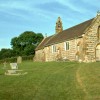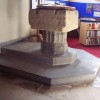A closer look at some family connections
It is I believe a common conception that those who research their family history are hopeful they might stumble upon at least one famous, and preferably wealthy, ancestor. This never once crossed my mind; I just needed to know who my ancestors were and where they came from. In the event it was enormously gratifying to discover that those of my direct male line were almost certainly farmers as far back as the early sixteenth-century, and that much later on there was a smattering of both wood-working and sea-faring blood in there too. All this makes perfect sense to me. And I now know exactly who I am, and to some extent, why I am the person I am. It is a great feeling, and I am sure many others researching their family history will concur.
During the process I have made some surprising discoveries, a few involving blood ancestors, and also some other more tenuous ancestral connections to well-known historical figures, places and events – even to writers of literature and to poets, no less. History, particularly as taught in my school-days, had singularly failed to inspire me; but now, with the search for my previously unknown family history, it has suddenly come alive.
I learned that my paternal 3xG. grandfather was another John Lane (1769-1840) a yeoman farmer of Lower Bridmore Farm, Berwick St. John in Wiltshire. Berwick St. John is a quiet, sleepy little village close to the Dorset border, a west-country picture-postcard village as one might easily imagine it – of quaint thatched cottages set against tall and colourful summer hollyhocks, or in winter, of wispy blue smoke curling up from stone chimneys into the cold still air of a frosty day. And whereas many a researcher might need to be content with a few documents such as parish records, BMD certificates and the odd will if they are lucky – I managed to hit an absolute goldmine.
John’s landlord was Thomas GROVE of Ferne. His daughter, Charlotte (1783-1860,) through her mother’s PILFORD family, was first cousin to none other than the poet Percy Bysshe Shelly. Rather late in life Charlotte married the village rector Richard DOWNES and between the years 1811-1860 she kept a diary, of which most years survive. Searching through the original diaries, now held at the Wiltshire Record Office, I found members of my Lane family mentioned in perhaps four hundred separate daily entries. As the squire’s unmarried daughter and later the rector’s wife, Charlotte had a tendency to treat parishioners as her very own, taking a great deal of interest in their everyday lives, whatever their social standing, and writing about them in her journal. So now, almost two hundred years later, I am able to draw a sketch, if not paint a picture, of John and Mansel Lane and their eight children – how they lived and farmed, who they loved and how they died; their frequent illnesses, their primitive education and the books they read. Recorded too were the tenant’s dinners – with the predictable effects of too much punch – dancing on the village green at Whitsuntide, parties, visits to Salisbury, or even to London, and trips to Shaston Fair.
I am greatly indebted to the present occupier at Bridmore for showing me around the farmhouse, which has remained tenanted and therefore virtually unchanged since those early times. There still are the eighteenth century white-painted panelled doors with original handles, the stairs leading up to the servants’ quarters in the attic and perhaps most poignantly for me, the window seats set into the thick stone walls. Here, if only in my imagination, once sat the three little Lane girls, Mansel, Betsey and Mary Ann, laughing and giggling as they sewed or read, or taking it in turns to play their piano; or where perhaps later, as young ladies, they huddled together and whispered in hushed tones the latest secrets of their respective “lovers.”
Mansel Moore Lane (1806-1861,) the first-born of these three girls, married James BRINE of Tolpuddle in 1838. A farmer of several hundred acres, James was thought unlikely to be of the same family as his more famous namesake, James Brine, the Tolpuddle Martyr. But further research revealed they were in fact first cousins. James Lane, my twice great grandfather and younger brother to Mansel, was working as a miller at Tolpuddle in 1851.
James Brine and Mansel had one child, Betsey Lane Brine, and sadly she died in 1854 aged just 14. All three are buried together at Tolpuddle with others of the Brine family on the south side of the churchyard. The badly-eroded limestone gravestones are covered with lichen, and already the inscriptions are mostly unreadable, as the stone begins to crumble and itself disappears into the past.
John Lane had married Mansel MOORE (1781-1857) at Fontmell Magna in 1805, Mansel being the only child of farmer Stafford MOORE (1781-1817) and Leah WAREHAM (1751-1795.) The Moores were part of an old-established family that had lived in and around Dorset’s Blackmoor Vale for many generations. Several Moore family wills testify to the established pattern – they were millers and yeoman farmers, and from settings similar to those as described in Thomas Hardy’s books – places and villages that include Kings Mill, Marnhull, Stalbridge, Todber, Stour Provost or Sturminster Newton. It is strange to think my ancestors might once have lived and worked in the very same dwellings, farms and mills, or perhaps frequented the inns and taverns that inspired Hardy enough to describe them in his now classic and timeless stories.
In 1640, Robert Moore (1605-1697,) my 8 x G.grandfather, was churchwarden at Marnhull, as presumably befitted his status in the community, as was later William, his eldest son. My 6xG.granfather Robert Moore (1680-1745) of the following generation, married Margaret BRAVEL at Stourpaine in 1711. At first the name Bravel meant very little to me, except that it cropped-up with increasing regularity in my research, both as a surname and as a given name, also that it was annoyingly ambiguous in its varied spelling – or more probably, mis-spelling. Nevertheless, Bravel, Bravell, Bravil, Braville or another variation, appears a most unusual name, and therefore worthy of further investigation.
Robert and Margaret had eleven known children, including an obligatory Stafford, a Mansell, a Palmer, a Bravel and a Richard Bravel. The first four of the eleven were baptised at Compton Abbas, at the church now left ruined in East Compton – to be found today down a little narrow winding lane, where there is also a farm and very little else. The remaining seven were baptised at Stour Provost, indicating perhaps a move by the family in about 1720, or possibly that the earlier children were baptised in the mother’s old parish, as was sometimes the customs in those days. Margaret, herself, was the eldest of two known surviving daughters of Richard Bravel (1650-1694,) a rector of Compton Abbas. Richard had studied at Oxford, the alumni records him as once Chaplain to the garrison of Tangiers, and later as a vicar of Welton, in Yorkshire. An interesting fellow perhaps, but as it transpired, nowhere near as interesting as his father Thomas.
To be contined…



